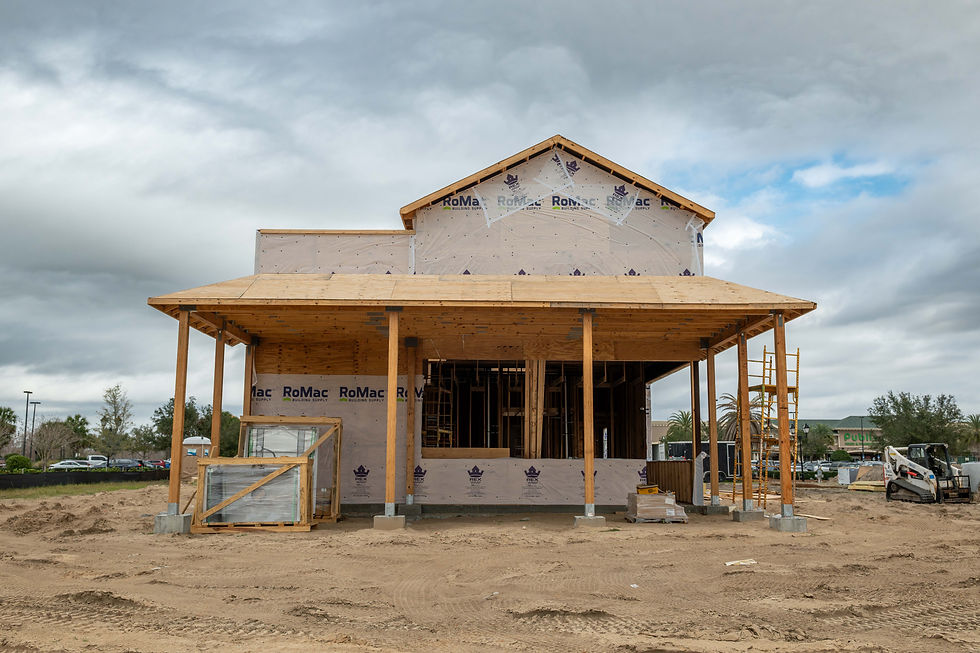Understanding House Wrap: The Unsung Hero of Your Home’s Protection
- RoMac Materials Expert
- Feb 3
- 3 min read

When building or renovating a home or commercial property, one crucial component often goes unnoticed—house wrap. While it may not be as visible as siding or roofing, house wrap plays a vital role in protecting a structure from the elements, improving energy efficiency, and enhancing long-term durability. In this blog, we’ll explore what house wrap is, why it’s essential, and how it benefits your home or commercial building.
What Is House Wrap?
House wrap is a weather-resistant barrier (WRB) installed between the sheathing and the exterior siding of a building. Made from synthetic materials like polyethylene or polypropylene, it serves as an additional protective layer against moisture and air infiltration while allowing trapped water vapor to escape. This unique functionality makes house wrap a critical element in modern construction.
The Key Benefits of House Wrap
1. Moisture Protection
One of the primary functions of house wrap is to act as a barrier against water infiltration. Rain and humidity can penetrate the exterior cladding of a home, leading to mold, mildew, and wood rot. House wrap helps keep moisture out while still allowing interior condensation to escape, preventing long-term structural damage.
2. Enhanced Energy Efficiency
House wrap improves a building’s energy efficiency by reducing air leaks. Without it, outdoor air can infiltrate a home, making HVAC systems work harder to maintain indoor temperatures. By sealing gaps and minimizing drafts, house wrap contributes to lower energy bills and a more comfortable living or working environment.
3. Increased Durability
Over time, exposure to moisture and fluctuating temperatures can weaken a building’s structure. House wrap provides an extra layer of defense, reducing the risk of deterioration. By keeping walls dry and insulated, it helps maintain the longevity of the building materials.
4. Mold and Mildew Prevention
A properly installed house wrap allows water vapor to escape, preventing the buildup of condensation within walls. This reduces the risk of mold and mildew growth, which can cause health issues and structural damage.
5. Better Indoor Air Quality
By blocking air leaks and keeping moisture at bay, house wrap contributes to better indoor air quality. It helps minimize the risk of allergens and pollutants entering the home, creating a healthier living space.

Choosing the Right House Wrap for Your Project
Not all house wraps are created equal. Depending on your climate and building needs, selecting the right product is essential. Consider factors such as permeability (how well it allows water vapor to escape), durability, and compatibility with other building materials. At RoMac Building Supply, we offer high-quality house wrap solutions designed to meet the needs of both residential and commercial construction projects.
Professional Installation Matters
While house wrap is an excellent protective measure, its effectiveness depends on proper installation. It should be applied with minimal seams, securely fastened, and correctly overlapped to ensure full coverage. Working with experienced professionals ensures your house wrap performs at its best, providing long-term protection.

Final Thoughts
House wrap might not be the most talked-about building material, but its role in protecting homes and commercial properties is invaluable. From moisture control and energy efficiency to durability and air quality, it offers numerous benefits that contribute to a well-built and long-lasting structure. Whether you're constructing a new building or renovating an existing one, investing in quality house wrap is a smart decision.
For expert advice on selecting the right house wrap for your project, contact RoMac Building Supply today. Our team is here to help you build smarter, stronger, and more efficient structures.







This article highlights an often-overlooked yet essential element in protecting a home—house wrap. It’s fascinating how something so simple can have such a big impact on insulation and weather protection. When thinking about the overall protection of a home, I also consider the air quality. Installing an air purifier for your home can significantly improve indoor air, removing dust, allergens, and pollutants that may sneak in despite the best house wraps. Ensuring both physical and air quality protection creates a much more comfortable and healthy living space for everyone inside.
Amigo Tyres is a Rocklea based store that supports truckers, families, and businesses with tyre replacement, repair, and mobile services. Visit the best truck wheel alignement in Rocklea !
Visit: https://amigotyres.com.au/services/tyre-rotation-service-in-rocklea , https://amigotyres.com.au/services/wheel-alignment-service-in-rocklea